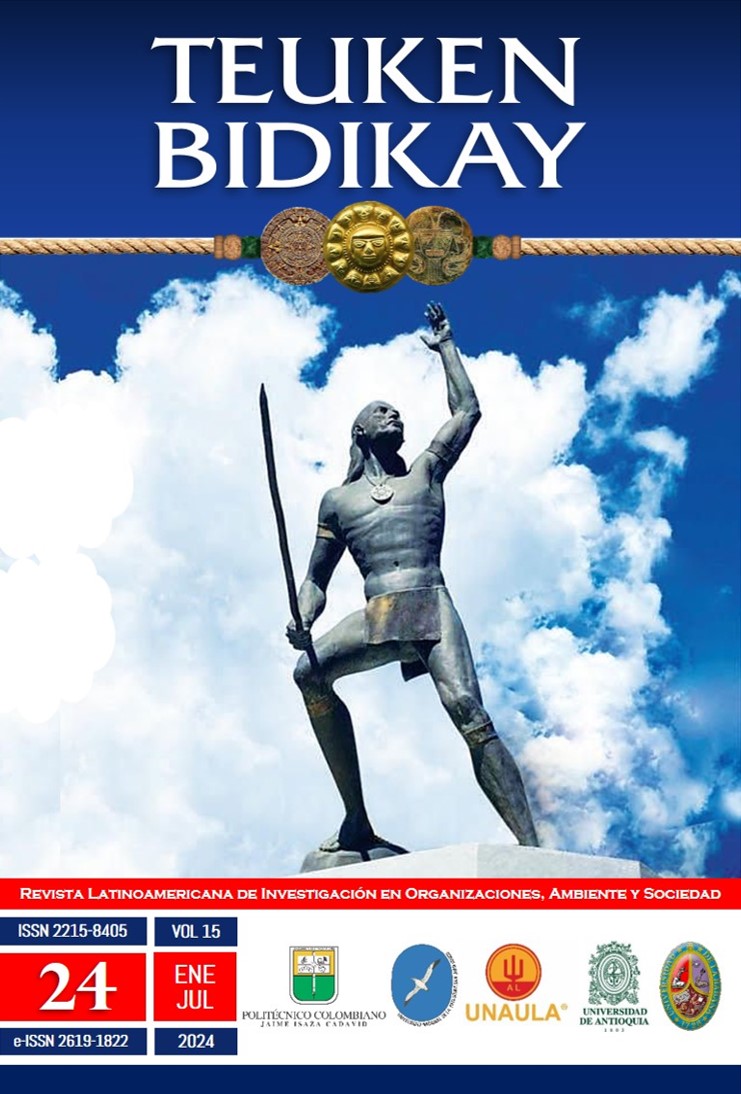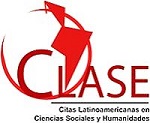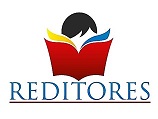STRATEGIC ANALYSIS OF STRUCTURES-PROCESSES IN FAMILY SMEs TO ACHIEVE POST PANDEMIC
DOI:
https://doi.org/10.33571/teuken.v15n24a2Keywords:
strategic analysis; family SMESs; structure; processes; resilience.Abstract
The difficult post-pandemic challenges that family businesses face refers to working, assisting, and helping to establish strategies that allow economies to overcome. The purpose of this study was the strategic analysis of the structures and processes of family cleaning service companies in Los Mochis, Sinaloa. Through a quantitative methodology with a descriptive scope. The results allow to relate aspects that lead to the introduction of a new model to understand the reality of the company, which allows it to anticipate future behaviors by carrying out actions in which its possible consequences are understood and, above all, to understand a problematic situation in which its variables and origin are found, making resilience essential as the ability to recover from constant changes, preparing to rebuild.
Keywords: strategic analysis; family SMESs; structure; processes; resilience.
Article Metrics
Abstract: 308 PDF (Español (España)): 115PlumX metrics
References
Acosta, A., Molina, C., Andino, T., y Carreño, D. (2019). Sistema familiar y continuidad de las empresas familiares. Revista de Ciencias Sociales, 25(4), 265-275. https://doi.org/10.31876/rcs.v25i4.30532 DOI: https://doi.org/10.31876/rcs.v25i4.30532
Acosta, A., Molina, C., Andino, T. y Carreño, D. (2023). Procesos de atracción de personal en empresas familiares y no familiares ecuatorianas. Revista de Ciencias Sociales, 29, 113-126. https://doi.org/10.31876/rcs.v29i.40451 DOI: https://doi.org/10.31876/rcs.v29i.40451
Adan, J., Munar, L., Romero, G. y Gordillo, A. (2022) Nuevos desafíos de las pequeñas y medianas empresas en tiempos de pandemia. Tecnura, 26(72), 185- 208. https://doi.org/10.14483/22487638.17879 DOI: https://doi.org/10.14483/22487638.17879
Chandler, (1962). Strategy and Structure: Chapters in the history of the American industrial enterprise. The MIT Press.
Charry, L. (2018, 26 de marzo). Las empresas familiares de América Latina. Avianca en Revista. https://www.aviancaenrevista.com/revista/empresas-familiares-america-latina/
Chiavenato, I. (2011). Administración de recursos humanos. El capital humano en las organizaciones. McGraw-Hill – Interamericana Editores, S.A. de C.V
Chrisman, J., Chua, J. & Sharma P. (2005). Trends and directions in the development of a strategic management theory of the family firm. Entrepreneurship Theory and Practice, 29(5), 555-675. https://doi.org/10.1111/j.1540-6520.2005.00098.x DOI: https://doi.org/10.1111/j.1540-6520.2005.00098.x
Comisión Económica para América Latina y el Caribe [CEPAL]. (2020a). Observatory in Latin America and the Caribbean Economic and social impact. https://www.cepal.org/en/topics/covid-19
Comisión Económica para América Latina y el Caribe [CEPAL]. (2020b). Sectores y empresas frente al COVID-19: emergencia y reactivación. http://repositorio.cepal.org/handle/11362/45734
Confederación Patronal de la República Mexicana [COPARMEX] (2021). Resumen informativo de Medios de Comunicación. https://www.coparmexlm.com/blog/resumen-de-medios-8/resumen-informativo-de-medios-de-comunicacion-28-01-2021-168
Consejo para el Desarrollo Económico de Sinaloa [CODESIN]. (2019). Indicador Trimestral de la Actividad Económica en Sinaloa, Tercer trimestre 2019. https://sinaloaennumeros.codesin.mx/actividad-economica-en-sinaloa-2019/
Cornejo, A. (2004). Complejidad y Caos. Guía para la Administración del Siglo XXI. Ediciones Castillo.
Directorio Estadístico Nacional de Unidades Económicas [DENUE]. (2019). https://www.inegi.org.mx/app/descarga/?ti=6
Dodero, S. (2019). El método EFE. El Ateneo.
Durán, J., Simón, J., Ferrón, J. y San Martín, J. (2016). La sucesión e institucionalización de la empresa familiar en México. Instituto Mexicano de Ejecutivos de Finanzas.
Fan, V., Jamison, D. & Summers, L. (2016). The inclusive cost of pandemic influenza risk. NBER Working Paper, (22137). https://doi.org/10.3386/w22137 DOI: https://doi.org/10.3386/w22137
Franko, L. G. (1974). The Move Toward a Multidivisional Structure in European Organizations. Administrative Science Quarterly, 19(4), 493–506. https://doi.org/10.2307/2391807 DOI: https://doi.org/10.2307/2391807
Freedman, L. (2016). Estrategia: una historia. La Esfera de los Libros.
Galán, J. & Sánchez-Bueno, M. (2009), The continuing validity of the strategy-structure nexus: new findings, 1993–2003. Strategic Management Journal, 30(11), 1.234-1.243. https://doi.org/10.1002/smj.782 DOI: https://doi.org/10.1002/smj.782
Grinyer, P. & Yasai-Ardekani, M. (1981). Strategy, structure, size and bureaucracy. Academy of Management Journal, 24(3), 471-486. https://doi.org/10.2307/255569 DOI: https://doi.org/10.2307/255569
Gu, X., Ying, S., Zhang, W. y Tao, Y. (2020). How do firms respond to COVID-19? First evidence from Suzhou, China. Emerging Markets Finance and Trade, 56(10), 2.181-2.197. https://doi.org/10.1080/1540496X.2020.1789455 DOI: https://doi.org/10.1080/1540496X.2020.1789455
Hall, D. & Saias, M. (1980): Strategy follows structure. Strategic Management Journal, 1(2), 149-163. https://doi.org/10.1002/smj.4250010205 DOI: https://doi.org/10.1002/smj.4250010205
Hamel, G. & Välikangas, L. (2003). En busca de la resiliencia. Harvard Business Review, 1(9).
Hernández, R. y Mendoza, T. (2018) Metodología de la Investigación. Las rutas cuantitativa, cualitativa y mixta. Ed. Mexicana.
Hernández-Sánchez, B., Cardella, G. & Sánchez-García, J. (2020). Psychological Factors that Lessen the Impact of COVID-19 on the Self-Employment Intention of Business Administration and Economics’ Students from Latin America. International Journal of Environmental Research and Public Health, 17(15), 1-22. https://doi.org/10.3390/ ijerph17155293 DOI: https://doi.org/10.3390/ijerph17155293
Instituto de Familias Empresarias para México y Latinoamérica. (2022). https://ifem.tec.mx/es
Instituto Nacional de Estadística y Geografía [INEGI] (2013). Micro, pequeña, mediana y gran empresa. Estratificación de los establecimientos. Censos económicos 2019. https://www.inegi.org.mx/programas/ce/2019/
Instituto Nacional de Estadística y Geografía [INEGI] (2020). Estudio sobre Demografía de los negocios 2020. https://www.inegi.org.mx/contenidos/productos/prod_serv/contenidos/espanol/bvinegi/productos/nueva_estruc/702825197421.pdf
Kottika, E., Özsomer, A., Rydén, P., Theodorakis, I., Kaminakis, K., Kottikas, K. & Stathakopoulos, V. (2020). We survived this! What managers could learn from SMEs who successfully navigated the Greek economic crisis. Industrial Marketing Management, 88, 352-365. https://doi.org/10.1016/j.indmarman.2020.05.021 DOI: https://doi.org/10.1016/j.indmarman.2020.05.021
Mintzberg, H., Quinn, J. y Voyer, J. (1997). El proceso estratégico: conceptos, contextos y casos. Prentice Hall Hispanoamericana, S.A.
Molina, C (2021). Empresas familiares, empresas conscientes. Legado, 6-10. https://ifem.tec.mx/sites/g/files/vgjovo626/files/CC%20Revista%20LEGADO%20Abril%202021.pdf
Montoya, L., Hernández, J. y Montoya, I. (2022). Marketing mutualista como estrategia emergente. Caso de la papa durante la pandemia de Covid en 2019. Teuken Bidikay, 13(20). https://doi.org/10.33571/teuken.v13n20a8 DOI: https://doi.org/10.33571/teuken.v13n20a8
Muñoz, Á. y Mayor, M. (2015). Las pyme en América Latina, Japón, la Unión Europea, Estados Unidos y los clúster en Colombia. Administración y Desarrollo, 45(1), 7-24. https://doi.org/10.22431/25005227.1 DOI: https://doi.org/10.22431/25005227.1
Muñoz-Silva, A. (2012). El estudio de la resiliencia desde la perspectiva evolutiva y su aportación a la comprensión del riesgo y la protección en la intervención social. Portularia, 12(1), 9-16. https://doi.org/10.5218/prts.2012.0029 DOI: https://doi.org/10.5218/prts.2012.0029
Núñez, Y. y Rodríguez, Carlos. (2015). Gestión de recursos intangibles en instituciones de educación superior. Revista de Administración de Empresas, 55(1), 65-77. http://dx.doi.org/10.1590/S0034-759 020150107 DOI: https://doi.org/10.1590/S0034-759020150107
Organización de las Naciones Unidas [ONU]. (2021). The 2014-2020 Period will mark the lowest growth in the last seven decades for Latin American and Caribbean Economies: ECLAC. https://www.cepal.org/en/pressreleases/2014-2020-period-will-mark-lowest-growth-last-seven-decades-latin-american-and
Pizzolante, I. (2003). La “Geometría” de la Comunicación Empresarial. Razón y Palabra, 34. https://dialnet.unirioja.es/servlet/articulo?codigo=717571
Rodríguez-Sánchez, A., Guinot, J., Chiva, R. y López-Cabrales, Á. (2021). How to emerge stronger: Antecedents and consequences of organizational resilience. Journal of Management & Organization, 27(3), 442-459. https://doi.org/10.1017/jmo.2019.5 DOI: https://doi.org/10.1017/jmo.2019.5
Rogel, E. y Urquizo, J. (2019). Aproximación teórica a la resiliencia en las organizaciones financieras. Revista de Ciencias Sociales, 25(2), 112-119. https://doi.org/10.31876/rcs.v25i2.27340 DOI: https://doi.org/10.31876/rcs.v25i2.27340
Salgado, C. (2012). La resiliencia y su empleo en las organizaciones. Gestión y Estrategia, (41), 29-40. https://doi.org/10.24275/uam/azc/dcsh/gye/2012n41/Medina DOI: https://doi.org/10.24275/uam/azc/dcsh/gye/2012n41/Medina
Samán, S., Mendoza, W., Miranda, M. y Esparza, R. (2022). Resiliencia y competitividad empresarial: una revisión sistemática, período 2011 – 2021. Revista de Ciencias Sociales, 28(3), 306-317. https://doi.org/10.31876/rcs.v28i3.38476 DOI: https://doi.org/10.31876/rcs.v28i3.38476
Sampedro, J. (2009). Ingenio estratégico. Resiliencia e impulso creativo en tiempos de crisis. https://glcconsulting.com.ve/wp-content/uploads/2015/10/Articulo_Ingenio-Estrategico_Jesus-Sampedro.pdf
Teece, D.J (2018). Business models and dynamic capabilities. Long Range Planning, 51(1), 40-49. https://doi.org/10.1016/j.lrp.2017.06.007 DOI: https://doi.org/10.1016/j.lrp.2017.06.007
Downloads
Published
How to Cite
Issue
Section
License
Copyright (c) 2024 LINDA GARCIA RODRIGUEZ, DARIO FUENTES GUEVARA, ERIK TAPIA MEJIA

This work is licensed under a Creative Commons Attribution-NonCommercial-ShareAlike 4.0 International License.


























